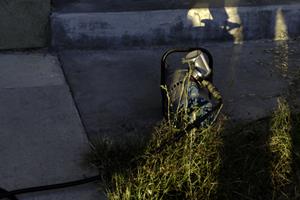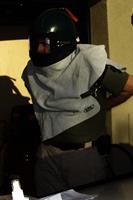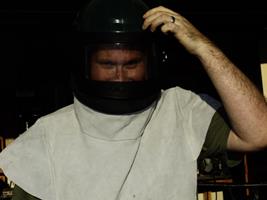TWiki> Gunwiki Web>ToolAirCompressor>ProcAbrasiveBlasting>RefRespiratorySafety (16 Apr 2012, SeanNewton)
Gunwiki Web>ToolAirCompressor>ProcAbrasiveBlasting>RefRespiratorySafety (16 Apr 2012, SeanNewton)
Gunwiki's Path on Respiratory SafetyDisclaimer: See a ProfessionalThere are a lot of different philosophies regarding respiratory safety. Ultimately, you should choose your path based upon an educated evaluation of risks and ideally a consultation with your physician and trained safety professionals. I am providing information on my respiratory safety setup for use as a reference. I am personally very risk-averse, and used professional, full-time abrasive blasting and finishing shops' safety systems as a reference. I consider it to be adequate for me and my guests; your mileage may vary.The Risks Being MitigatedWhile there are plenty of short-term reasons to care about respiratory safety, the most compelling ones are long-term.
Approaches to SafetyThere are three main approaches, each with their own drawbacks.
About Supplied Air SystemsI'll go into a bit of depth here because this is what I'm most familiar with. I really like this approach the best, because there's very little chance of missing anything. Clean air comes in, you breathe it, and it gets dumped out into your environment. No risk of a filter not being rated correctly or your mask not being properly sealed, or a seam in your blasting cabinet being too loose and then you're breathing a cloud of sand dust. Here's what you CAN'T do, though: You can't use a normal air compressor. A normal air compressor has a pump system which is not designed to produce breathable air. The air it puts out typically includes oil, may include rust, and will usually include quite a bit of condensation. You could also be getting exhaust fumes from the motor (toxic ozone in the case of an electric motor, carbon monoxide in the case of gasoline), etc. As inexpensive as a second-hand respiratory grade compressor is, you may as well get the right tool for the job.Sean Newton's system (supplied air respiration)Supplied air respiration is probably the most costly method, but it's theoretically capable of perfect protection. It cost me just under $1k, but it's near-flawless protection for two people (since I'm teaching someone more often than not). The compressor in particular would've been much more expensive had it not been bought used. I personally don't like the thought of wearing someone else's used respirator mask, so that was bought new - but if you look around, it's possible to get decent bargains on them. Please note that a one-person half-mask respirator setup could easily be done with the lower-end Allegro A-500, for a total cost under $400. Or around $200 if you were to improvise something using a shop vac or dust collector to supply the air. If you DO try this, you need to place a filter over the air intake AND a second one in your air supply hose. This certainly wouldn't pass any kind of OSHA inspection, but it's probably still safer than trusting a filter cartridge that isn't designed for sand blasting. Just about anything is.
PIctures The Allegro 750 respiratory-grade air compressor. It's effectively a snorkel system which pumps breathable air through an arbitrarily long respiratory-grade air line. This allows you to place the air intake an arbitrary distance away from the blasting cabinet, paint booth, or whatever else you're doing. You can also run an intake hose off of the compressor to somewhere else too, if you want even more separation between your work area and the source of your breathing air.
The Allegro 750 respiratory-grade air compressor. It's effectively a snorkel system which pumps breathable air through an arbitrarily long respiratory-grade air line. This allows you to place the air intake an arbitrary distance away from the blasting cabinet, paint booth, or whatever else you're doing. You can also run an intake hose off of the compressor to somewhere else too, if you want even more separation between your work area and the source of your breathing air.
 The compressor doesn't do any good if there's no way to get the air to you. I use either a Nova 2000 full helmet (depicted) or an Allegro half-mask system. The half-mask draws little enough air that two can breathe with it, while the Nova is strictly for one-respirator use. The Nova 2000 is a heavy-duty helmet which will keep contaminants away from pretty much everywhere. The attached tunic is leather, which provides protection from flying fragments, etc.
The compressor doesn't do any good if there's no way to get the air to you. I use either a Nova 2000 full helmet (depicted) or an Allegro half-mask system. The half-mask draws little enough air that two can breathe with it, while the Nova is strictly for one-respirator use. The Nova 2000 is a heavy-duty helmet which will keep contaminants away from pretty much everywhere. The attached tunic is leather, which provides protection from flying fragments, etc.
 The viewport has a plastic shield over it, which ensures that ricocheted blasting media won't scratch or put the underlying glass visor.
The viewport has a plastic shield over it, which ensures that ricocheted blasting media won't scratch or put the underlying glass visor.
-- SeanNewton - 08 Apr 2012 |
Topic revision: r4 - 16 Apr 2012 - SeanNewton

Ideas, requests, problems regarding TWiki? Send feedback










